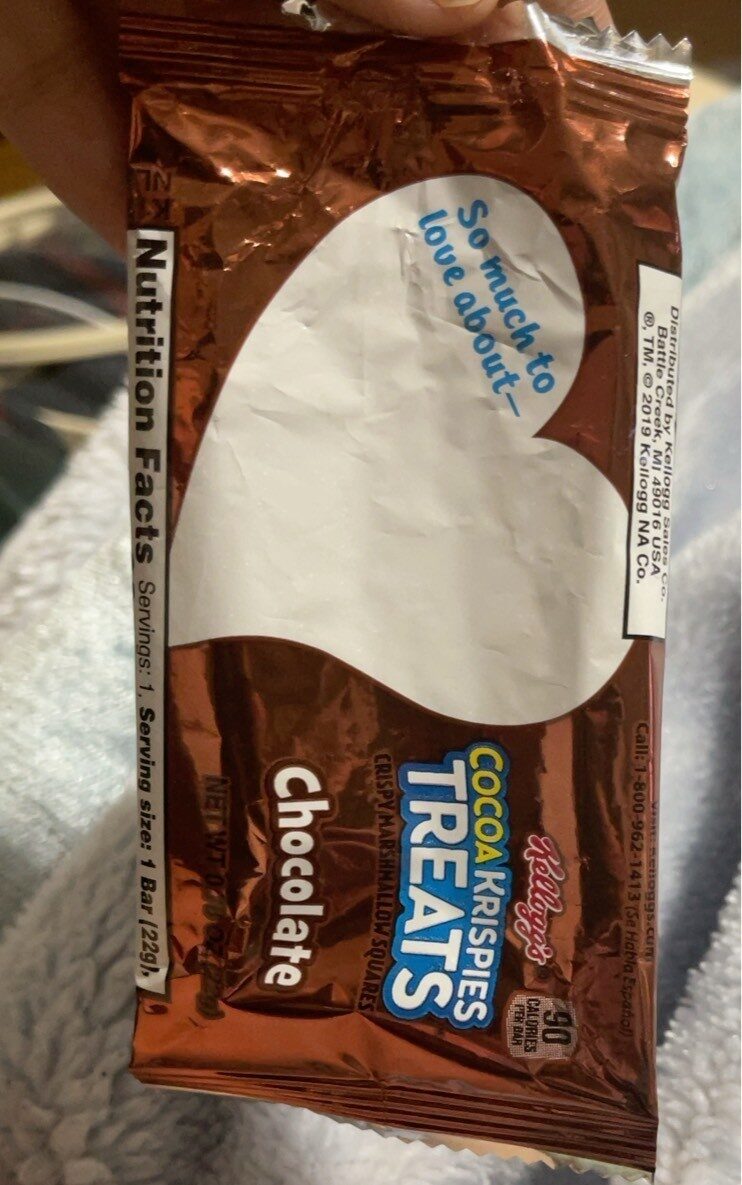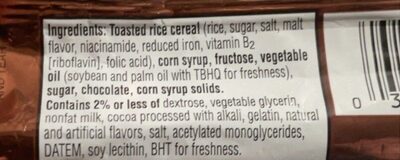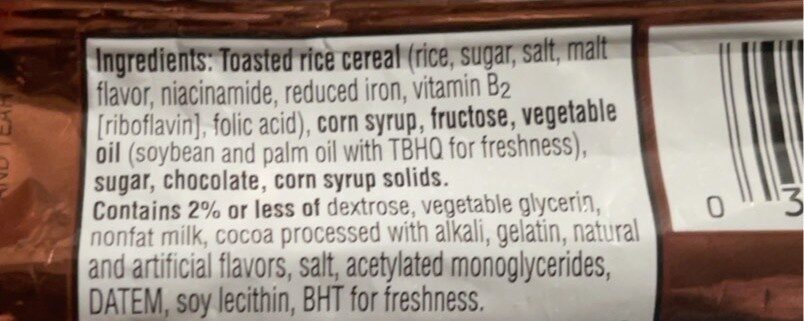Help us make food transparency the norm!
As a non-profit organization, we depend on your donations to continue informing consumers around the world about what they eat.
The food revolution starts with you!
Cocoa krispies treats -
Cocoa krispies treats -
Ang pahina ng produkto ay hindi kumpleto. Makakatulong ka sa pagkompleto nito sa pamamagitan ng pag-edit at pagdagdag ng higit pang data mula sa mga larawan na mayroon kami, o sa pamamagitan ng pagkuha ng larawan gamit ang app sa Android or iPhone/iPad. Salamat!
×
Barcode: 0038000157486 (EAN / EAN-13) 038000157486 (UPC / UPC-A)
Brand owner: The Kellogg Company
Mga kategorya: en:Snacks, en:Sweet snacks, en:Biscuits and cakes, Kakanin
Mga bansa kung saan ibinebenta: Pilipinas, Estados Unidos
Matching with your preferences
Health
Mga Sangkap
-
35 ingredients
: Rice cereal (rice, sugar, salt, malt flavoring, niacinamide, reduced iron, vitamin b2 [riboflavin], folic acid), corn syrup, fructose, soybean and palm oil with tbhq for freshness, chocolate, sugar, corn syrup solids, contains 2% or less of dextrose, glycerin, nonfat milk, cocoa (processed with alkali), gelatin, natural and artificial flavors, acetylated monoglycerides, datem, bht for freshness, niacinamide, vitamin b6 (pyridoxine hydrochloride), cellulose, vitamin b1 (thiamin hydrochloride), vitamin b2 (riboflavin), soy lecithin.Mga allergen: en:Gelatin, en:Milk, en:Soybeans
Food processing
-
Ultra processed foods
Elements that indicate the product is in the en:4 - Ultra processed food and drink products group:
- Sangkap: E322
- Sangkap: E422
- Sangkap: E428
- Sangkap: E460
- Sangkap: E472e
- Sangkap: Flavouring
Food products are classified into 4 groups according to their degree of processing:
- Unprocessed or minimally processed foods
- Processed culinary ingredients
- Processed foods
- Ultra processed foods
The determination of the group is based on the category of the product and on the ingredients it contains.
Mga sangkap
-
E322
Lecithin: Lecithin -UK: , US: , from the Greek lekithos, "egg yolk"- is a generic term to designate any group of yellow-brownish fatty substances occurring in animal and plant tissues, which are amphiphilic – they attract both water and fatty substances -and so are both hydrophilic and lipophilic-, and are used for smoothing food textures, dissolving powders -emulsifying-, homogenizing liquid mixtures, and repelling sticking materials.Lecithins are mixtures of glycerophospholipids including phosphatidylcholine, phosphatidylethanolamine, phosphatidylinositol, phosphatidylserine, and phosphatidic acid.Lecithin was first isolated in 1845 by the French chemist and pharmacist Theodore Gobley. In 1850, he named the phosphatidylcholine lécithine. Gobley originally isolated lecithin from egg yolk—λέκιθος lekithos is "egg yolk" in Ancient Greek—and established the complete chemical formula of phosphatidylcholine in 1874; in between, he had demonstrated the presence of lecithin in a variety of biological matters, including venous blood, in human lungs, bile, human brain tissue, fish eggs, fish roe, and chicken and sheep brain. Lecithin can easily be extracted chemically using solvents such as hexane, ethanol, acetone, petroleum ether, benzene, etc., or extraction can be done mechanically. It is usually available from sources such as soybeans, eggs, milk, marine sources, rapeseed, cottonseed, and sunflower. It has low solubility in water, but is an excellent emulsifier. In aqueous solution, its phospholipids can form either liposomes, bilayer sheets, micelles, or lamellar structures, depending on hydration and temperature. This results in a type of surfactant that usually is classified as amphipathic. Lecithin is sold as a food additive and dietary supplement. In cooking, it is sometimes used as an emulsifier and to prevent sticking, for example in nonstick cooking spray.Source: Wikipedia (Wikang Ingles)
-
E322i
Lecithin: Lecithin -UK: , US: , from the Greek lekithos, "egg yolk"- is a generic term to designate any group of yellow-brownish fatty substances occurring in animal and plant tissues, which are amphiphilic – they attract both water and fatty substances -and so are both hydrophilic and lipophilic-, and are used for smoothing food textures, dissolving powders -emulsifying-, homogenizing liquid mixtures, and repelling sticking materials.Lecithins are mixtures of glycerophospholipids including phosphatidylcholine, phosphatidylethanolamine, phosphatidylinositol, phosphatidylserine, and phosphatidic acid.Lecithin was first isolated in 1845 by the French chemist and pharmacist Theodore Gobley. In 1850, he named the phosphatidylcholine lécithine. Gobley originally isolated lecithin from egg yolk—λέκιθος lekithos is "egg yolk" in Ancient Greek—and established the complete chemical formula of phosphatidylcholine in 1874; in between, he had demonstrated the presence of lecithin in a variety of biological matters, including venous blood, in human lungs, bile, human brain tissue, fish eggs, fish roe, and chicken and sheep brain. Lecithin can easily be extracted chemically using solvents such as hexane, ethanol, acetone, petroleum ether, benzene, etc., or extraction can be done mechanically. It is usually available from sources such as soybeans, eggs, milk, marine sources, rapeseed, cottonseed, and sunflower. It has low solubility in water, but is an excellent emulsifier. In aqueous solution, its phospholipids can form either liposomes, bilayer sheets, micelles, or lamellar structures, depending on hydration and temperature. This results in a type of surfactant that usually is classified as amphipathic. Lecithin is sold as a food additive and dietary supplement. In cooking, it is sometimes used as an emulsifier and to prevent sticking, for example in nonstick cooking spray.Source: Wikipedia (Wikang Ingles)
-
E422
Glycerol: Glycerol -; also called glycerine or glycerin; see spelling differences- is a simple polyol compound. It is a colorless, odorless, viscous liquid that is sweet-tasting and non-toxic. The glycerol backbone is found in all lipids known as triglycerides. It is widely used in the food industry as a sweetener and humectant and in pharmaceutical formulations. Glycerol has three hydroxyl groups that are responsible for its solubility in water and its hygroscopic nature.Source: Wikipedia (Wikang Ingles)
-
E460
Cellulose: Cellulose is an organic compound with the formula -C6H10O5-n, a polysaccharide consisting of a linear chain of several hundred to many thousands of β-1→4- linked D-glucose units. Cellulose is an important structural component of the primary cell wall of green plants, many forms of algae and the oomycetes. Some species of bacteria secrete it to form biofilms. Cellulose is the most abundant organic polymer on Earth. The cellulose content of cotton fiber is 90%, that of wood is 40–50%, and that of dried hemp is approximately 57%.Cellulose is mainly used to produce paperboard and paper. Smaller quantities are converted into a wide variety of derivative products such as cellophane and rayon. Conversion of cellulose from energy crops into biofuels such as cellulosic ethanol is under development as a renewable fuel source. Cellulose for industrial use is mainly obtained from wood pulp and cotton.Some animals, particularly ruminants and termites, can digest cellulose with the help of symbiotic micro-organisms that live in their guts, such as Trichonympha. In human nutrition, cellulose is a non-digestible constituent of insoluble dietary fiber, acting as a hydrophilic bulking agent for feces and potentially aiding in defecation.Source: Wikipedia (Wikang Ingles)
Pagsusuri ng sangkap
-
en:May contain palm oil
Ingredients that may contain palm oil: E472e
-
en:Non-vegan
Non-vegan ingredients: en:Skimmed milk, E428Some ingredients could not be recognized.
We need your help!
You can help us recognize more ingredients and better analyze the list of ingredients for this product and others:
- Edit this product page to correct spelling mistakes in the ingredients list, and/or to remove ingredients in other languages and sentences that are not related to the ingredients.
- Add new entries, synonyms or translations to our multilingual lists of ingredients, ingredient processing methods, and labels.
If you would like to help, join the #ingredients channel on our Slack discussion space and/or learn about ingredients analysis on our wiki. Thank you!
-
en:Non-vegetarian
Non-vegetarian ingredients: E428Some ingredients could not be recognized.
We need your help!
You can help us recognize more ingredients and better analyze the list of ingredients for this product and others:
- Edit this product page to correct spelling mistakes in the ingredients list, and/or to remove ingredients in other languages and sentences that are not related to the ingredients.
- Add new entries, synonyms or translations to our multilingual lists of ingredients, ingredient processing methods, and labels.
If you would like to help, join the #ingredients channel on our Slack discussion space and/or learn about ingredients analysis on our wiki. Thank you!
-
Details of the analysis of the ingredients
We need your help!
Some ingredients could not be recognized.
We need your help!
You can help us recognize more ingredients and better analyze the list of ingredients for this product and others:
- Edit this product page to correct spelling mistakes in the ingredients list, and/or to remove ingredients in other languages and sentences that are not related to the ingredients.
- Add new entries, synonyms or translations to our multilingual lists of ingredients, ingredient processing methods, and labels.
If you would like to help, join the #ingredients channel on our Slack discussion space and/or learn about ingredients analysis on our wiki. Thank you!
: Rice cereal (rice, sugar, salt, malt flavoring, niacinamide, reduced iron, vitamin b2 (riboflavin), folic acid), corn syrup, fructose, soybean and palm oil with tbhq for freshness, chocolate, sugar, corn syrup solids, contains 2% and less of dextrose, glycerin, nonfat milk, cocoa (processed with alkali), gelatin, natural and artificial flavors, acetylated monoglycerides, datem, bht for freshness, niacinamide, vitamin b6 (pyridoxine hydrochloride), cellulose, vitamin b1 (thiamin hydrochloride), vitamin b2 (riboflavin), soy lecithin- Rice cereal -> en:rice-cereal
- rice -> en:rice - vegan: yes - vegetarian: yes - ciqual_proxy_food_code: 9100
- sugar -> en:sugar - vegan: yes - vegetarian: yes - ciqual_proxy_food_code: 31016
- salt -> en:salt - vegan: yes - vegetarian: yes - ciqual_food_code: 11058
- malt flavoring -> en:malt-flavouring - vegan: maybe - vegetarian: maybe
- niacinamide -> en:e375 - vegan: maybe - vegetarian: maybe
- reduced iron -> en:reduced-iron
- vitamin b2 -> en:e101 - vegan: maybe - vegetarian: yes
- riboflavin -> en:e101 - vegan: maybe - vegetarian: yes
- folic acid -> en:folic-acid
- corn syrup -> en:corn-syrup - vegan: yes - vegetarian: yes - ciqual_proxy_food_code: 31089
- fructose -> en:fructose - vegan: yes - vegetarian: yes - ciqual_food_code: 31077
- soybean and palm oil with tbhq for freshness -> en:soybean-and-palm-oil-with-tbhq-for-freshness
- chocolate -> en:chocolate - vegan: maybe - vegetarian: yes
- sugar -> en:sugar - vegan: yes - vegetarian: yes - ciqual_proxy_food_code: 31016
- corn syrup solids -> en:corn-syrup-solids - vegan: yes - vegetarian: yes - ciqual_proxy_food_code: 31089
- contains 2% and less of dextrose -> en:contains-2-and-less-of-dextrose
- glycerin -> en:e422 - vegan: maybe - vegetarian: maybe
- nonfat milk -> en:skimmed-milk - vegan: no - vegetarian: yes - ciqual_proxy_food_code: 19051
- cocoa -> en:cocoa - vegan: yes - vegetarian: yes - ciqual_proxy_food_code: 18100
- processed with alkali -> en:processed-with-alkali
- gelatin -> en:e428 - vegan: no - vegetarian: no
- natural and artificial flavors -> en:natural-and-artificial-flavouring - vegan: maybe - vegetarian: maybe
- acetylated monoglycerides -> en:acetylated-monoglycerides
- datem -> en:e472e - vegan: maybe - vegetarian: maybe - from_palm_oil: maybe
- bht for freshness -> en:bht-for-freshness
- niacinamide -> en:e375 - vegan: maybe - vegetarian: maybe
- vitamin b6 -> en:vitamin-b6 - vegan: yes - vegetarian: yes
- pyridoxine hydrochloride -> en:pyridoxine-hydrochloride - vegan: yes - vegetarian: yes
- cellulose -> en:e460 - vegan: yes - vegetarian: yes
- vitamin b1 -> en:thiamin
- thiamin hydrochloride -> en:thiamin-hydrochloride
- vitamin b2 -> en:e101 - vegan: maybe - vegetarian: yes
- riboflavin -> en:e101 - vegan: maybe - vegetarian: yes
- soy lecithin -> en:soya-lecithin - vegan: yes - vegetarian: yes - ciqual_food_code: 42200
Nutrisyon
-
Bad nutritional quality
⚠ ️Warning: the amount of fruits, vegetables and nuts is not specified on the label, it was estimated from the list of ingredients: 0This product is not considered a beverage for the calculation of the Nutri-Score.
Positive points: 0
- Mga Protina: 2 / 5 (halaga: 4.5454545454545, rounded value: 4.55)
- Fiber: 0 / 5 (halaga: 0, rounded value: 0)
- Fruits, vegetables, nuts, and colza/walnut/olive oils: 0 / 5 (halaga: 0, rounded value: 0)
Negative points: 21
- Inirhiya: 5 / 10 (halaga: 1712, rounded value: 1712)
- Mga asukal: 7 / 10 (halaga: 31.818181818182, rounded value: 31.82)
- Saturated na taba: 4 / 10 (halaga: 4.5454545454545, rounded value: 4.5)
- Sodium: 5 / 10 (halaga: 454.54545454544, rounded value: 454.5)
The points for proteins are not counted because the negative points are greater or equal to 11.
Nutritional score: (21 - 0)
Nutri-Score:
-
Mga antas ng sustansya
-
Fat sa katamtaman ang dami (13.6%)
What you need to know- A high consumption of fat, especially saturated fats, can raise cholesterol, which increases the risk of heart diseases.
Recommendation: Limit the consumption of fat and saturated fat- Choose products with lower fat and saturated fat content.
-
Saturated fat sa katamtaman ang dami (4.55%)
What you need to know- A high consumption of fat, especially saturated fats, can raise cholesterol, which increases the risk of heart diseases.
Recommendation: Limit the consumption of fat and saturated fat- Choose products with lower fat and saturated fat content.
-
Asukal sa malaking kandidad (31.8%)
What you need to know- A high consumption of sugar can cause weight gain and tooth decay. It also augments the risk of type 2 diabetes and cardio-vascular diseases.
Recommendation: Limit the consumption of sugar and sugary drinks- Sugary drinks (such as sodas, fruit beverages, and fruit juices and nectars) should be limited as much as possible (no more than 1 glass a day).
- Choose products with lower sugar content and reduce the consumption of products with added sugars.
-
Asin sa katamtaman ang dami (1.14%)
What you need to know- A high consumption of salt (or sodium) can cause raised blood pressure, which can increase the risk of heart disease and stroke.
- Many people who have high blood pressure do not know it, as there are often no symptoms.
- Most people consume too much salt (on average 9 to 12 grams per day), around twice the recommended maximum level of intake.
Recommendation: Limit the consumption of salt and salted food- Reduce the quantity of salt used when cooking, and don't salt again at the table.
- Limit the consumption of salty snacks and choose products with lower salt content.
-
-
Mga katotohanan ng Nutrisyon
Mga katotohanan ng Nutrisyon As sold
para sa 100 g / 100 mlAs sold
bawat serving (1 BAR (22 g))Compared to: en:Biscuits and cakes Enerhiya 1,712 kj
(409 kcal)377 kj
(90 kcal)-8% Fat 13.636 g 3 g -18% Saturated fat 4.545 g 1 g -49% Trans fat 0 g 0 g Kolesterol 0 mg 0 mg -100% Carbohydrates 72.727 g 16 g +12% Asukal 31.818 g 7 g +10% Fiber 0 g 0 g -100% Protina 4.545 g 1 g -27% Asin 1.136 g 0.25 g +77% Vitamin A 0 µg 0 µg Bitamina C 0 mg 0 mg Vitamin B1 (Thiamin) 1 mg 0.22 mg Vitamin B2 (Riboflavin) 1.545 mg 0.34 mg Vitamin B3 9.091 mg 2 mg Vitamin B6 (Pyridoxin) 1.364 mg 0.3 mg Kalsiyo 0 mg 0 mg Bakal 3.27 mg 0.719 mg +54% Fruits‚ vegetables‚ nuts and rapeseed‚ walnut and olive oils (estimate from ingredients list analysis) 0 % 0 %
Kapaligiran
-
Eco-Score not computed - Unknown environmental impact
We could not compute the Eco-Score of this product as it is missing some data, could you help complete it?Could you add a precise product category so that we can compute the Eco-Score? Add a category
Balot
-
Missing packaging information for this product
⚠ ️ The information about the packaging of this product is not filled in.Take a photo of the recycling information Take a photo of the recycling information
Transportation
-
Origins of ingredients
Missing origins of ingredients information
⚠ ️ The origins of the ingredients of this product are not indicated.
If they are indicated on the packaging, you can modify the product sheet and add them.
If you are the manufacturer of this product, you can send us the information with our free platform for producers.Add the origins of ingredients for this product Add the origins of ingredients for this product
Report a problem
-
Incomplete or incorrect information?
Category, labels, ingredients, allergens, nutritional information, photos etc.
If the information does not match the information on the packaging, please complete or correct it. Open Food Facts is a collaborative database, and every contribution is useful for all.
Data sources
Produkto idinagdag sa sa pamamagitan ng openfoodfacts-contributors
Huling pag-edit ng pahina ng produkto sa pamamagitan ng kiliweb.
Pahina ng produkto ay na-edit din ni org-database-usda, yuka.sY2b0xO6T85zoF3NwEKvlk5mTcLmgB-UFUXtmkeQnemxcZu5bohxw7DjCKs.










